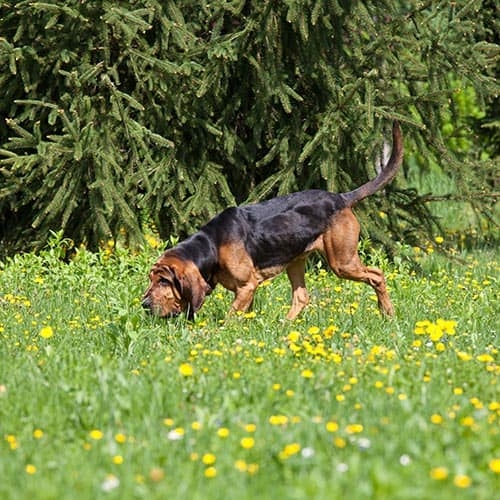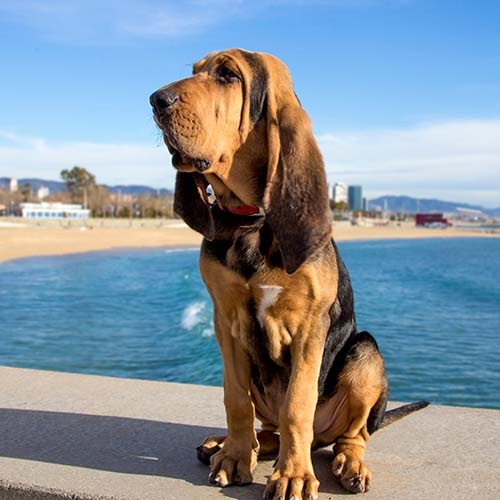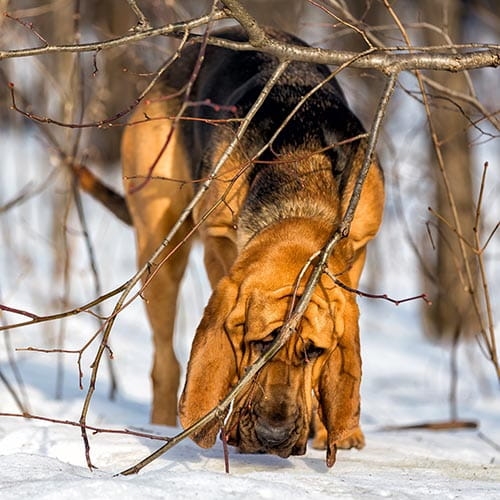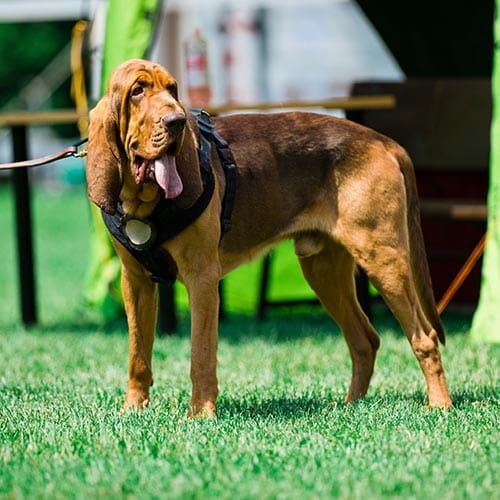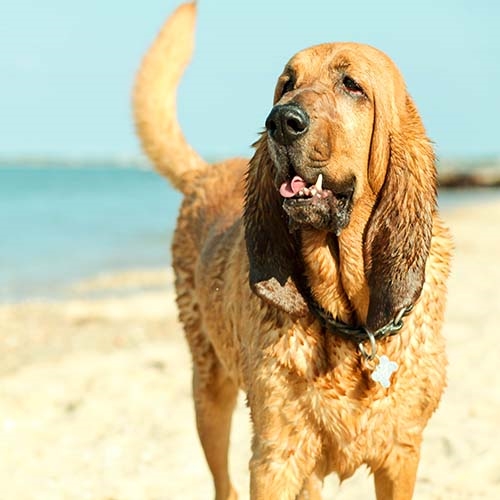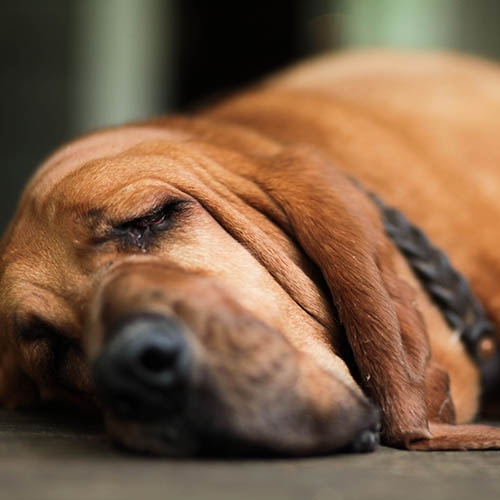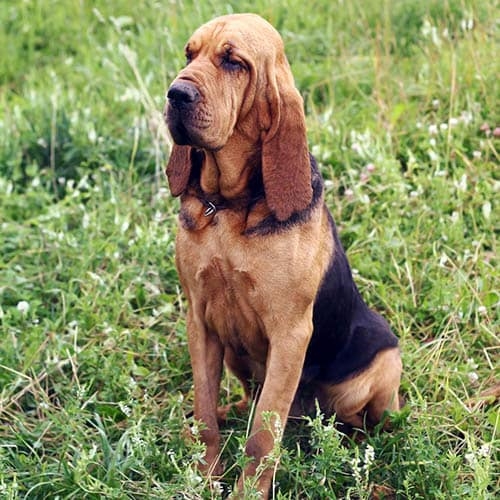| Size | Large |
|---|---|
| Average height | 61-66 cm |
| Average weight | 45-50 kg |
| Average lifespan | Under 10 years |
| Minimum exercise (per day) | 2 hours |
| Coat length | Short |
| Minimum cost (per month) | £80 |
Bloodhounds are gentle and placid dogs known for their amazing sense of smell. They’re super active and need lots of exercise, so make great pets for active families who can meet their needs.
Bred for tracking and hunting, Bloodhounds are often used as sniffer dogs nowadays. They can be easy to train in the right hands and respond really well to positive training methods. They’re affectionate dogs and very easy-going in the home environment.
Common health problems in Bloodhounds
Bloodhounds are gentle giants who can make good family pets. Unfortunately, like other purebred dogs, they are prone to certain conditions relating to their breed.
If you are thinking of buying a Bloodhound puppy, make sure the parents of your puppy have had the relevant health screening to reduce the chances of your puppy being affected by certain conditions. We’d recommend looking for a Kennel Club Assured Breeder as they meet extra requirements which will benefit your puppy’s health.
Bloodhounds are amongst a group of breeds classed as ‘Category Three’ by The Kennel Club. This means that they have been bred to look a certain way, which can cause them problems and discomfort. In the case of Bloodhounds, this is the loose skin around their eyes which can easily get infected or cause problems with their sight.
Some of the conditions Bloodhounds may develop include:
- Hip dysplasia – where the hip joint doesn’t fit together perfectly, which will eventually lead to arthritis. Before breeding, dogs should be screened by x-rays through the BVA/Kennel Club Hip Dysplasia Scheme.
- Elbow dysplasia – where the elbow joint doesn’t fit together perfectly, which will eventually lead to arthritis. Before breeding, dogs should be screened by x-rays through the BVA/Kennel Club Elbow Dysplasia Scheme.
- Gastric Dilatation Volvulus (GDV) – where a dog’s stomach bloats and twists around on itself, which can be fatal.
- Eye problems – such as ectropion, entropion and corneal ulcers.
- Atopy – itchy skin caused by sensitivity to things in the environment (such as pollen, grass and dust mites).
- Ear infections.
If you want to minimise the risk of your dog getting problems, you can read our advice on choosing a pedigree dog.
Caring for your Bloodhound
Bloodhounds are a high maintenance breed due their exercise needs, so are better suited to experienced owners who understand the breed. They are very affectionate dogs and can suit families really well.
While Bloodhounds are loyal dogs who form strong bonds with their families, they’re more likely to be destructive around the home if they get bored. Because they’re such active dogs, you need to make sure there’s enough to keep them occupied or your furniture could pay the price!
Bloodhounds and barking
As with any dog, your Bloodhound is likely to make noise and this will be down to their training and personality. Bloodhounds are known for having a loud, deep bark which they tend to use only when necessary (so if they’re bored, want your attention or something different is going on!). If you’re having problems with excessive noise, we recommend seeking the advice of an accredited behaviourist.
Training and socialisation
Bloodhounds are sensitive dogs and respond really well to positive, reward-based training from an early age. They can be wilful at times, so you need to patient and persistent with their training. Because of their keen sense of smell they can be easily distracted if they catch the scent of something interesting! For this reason we wouldn’t recommend a Bloodhound if you’re a first time owner. If you need a bit of extra guidance with training, we’d recommend taking them to accredited training classes.
Generally speaking, Bloodhounds aren’t aggressive dogs but can sometimes be nervous so it’s important to socialise your Bloodhound from a young age with lots of people, dogs and experiences. This will help them grow into confident and calm adults.
Although they form strong bonds with their owners, Bloodhounds aren’t a breed known to suffer with separation anxiety. This said, you should never leave your dog alone for more than four hours and you will need to train them that it’s OK to be alone.
Exercise
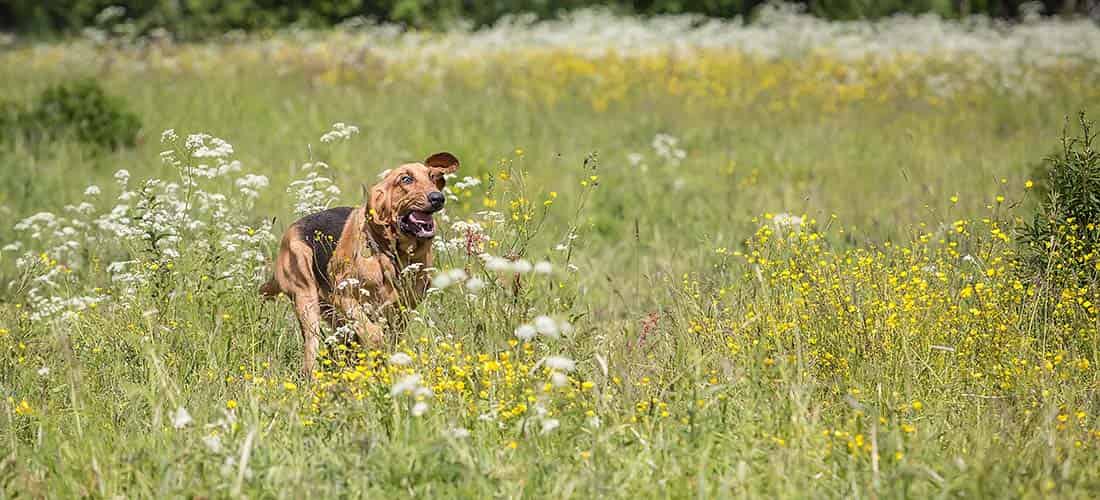
Bloodhounds are very active dogs with really high exercise needs. If you love to be out and about a lot in dog-friendly places, then they may well be the breed for you!
Your Bloodhound will need a minimum of two hours exercise every day, but the more the better! This needs to be split in to several walks. Your Bloodhound will really enjoy long, interesting walks where there’s lots to sniff! They should also be given time to run and play off-lead in a secure area. Despite their size, Bloodhounds were bred to follow scents over vast areas. They can fit through surprisingly small spaces, so a secure garden is an absolute must and the outside world can smell very tempting.
On top of their two hours, your Bloodhound will also need plenty to keep their brain active. This can include lots of games with you, training sessions and challenging puzzle toys and games to get them thinking. Don’t forget scent games which will lend themselves well to your Bloodhounds natural instincts.
Grooming
Their short fur means your Bloodhound will only need a weekly brush to keep on top of any dead hairs. They do shed throughout the year but not as much as breeds with longer fur. Bloodhounds are known for having a particular smell about them which may take a bit of getting used to!
You’ll find that your Bloodhound is a drooler – this is where they are a little more high maintenance on the grooming front! While they are very sweet dogs, they’re not the best breed for house-proud owners. If you don’t mind mopping up the drool then you should be fine!
Bloodhounds have very sensitive skin so always talk to your vet before buying any dog-friendly shampoos for them. It’s important to make sure their skin folds are kept clean and dry and regularly check their ears for signs of infection.
Bloodhounds and children
Bloodhounds might be big, but they have very gentle and placid natures. This means that they are likely to get along with children of all ages, however due to their size we wouldn’t recommend having a Bloodhound if you have smaller children. They could accidentally knock them over.
Remember to make sure you can recognise your dog’s body language so you can put a stop to any potentially stressful situations before they escalate. Always supervise your dog with children and vulnerable adults.
Bloodhounds and other pets
As long as your Bloodhound has been socialised well from a young age, they should get along fine with other dogs.
Bloodhounds do have a very high prey drive, so we wouldn’t advise keeping them with smaller pets. They may get along OK with a cat they have grown up with, but you should always supervise your Bloodhound with other animals in the home.
Food
Your Bloodhound’s diet will vary depending on their age. You’ll need to feed them a complete, balanced dog food to keep them slim and healthy.
Your vet will be able to tell you how much your Bloodhound should be eating. You should feed them a good quality, commercially available, complete dog food. We usually recommend splitting their daily allowance into two meals. If you give your dog the occasional treat or use treats for training, remember to take this into account and reduce their daily allowance. Treats shouldn’t make up more than 10% of their daily calorie intake as this can unbalance their diet.
Try to feed your dog at similar times every day as they like routine. Remember to leave a gap between eating and exercising as this is thought to reduce the risk of GDV.
The cost of owning a Bloodhound
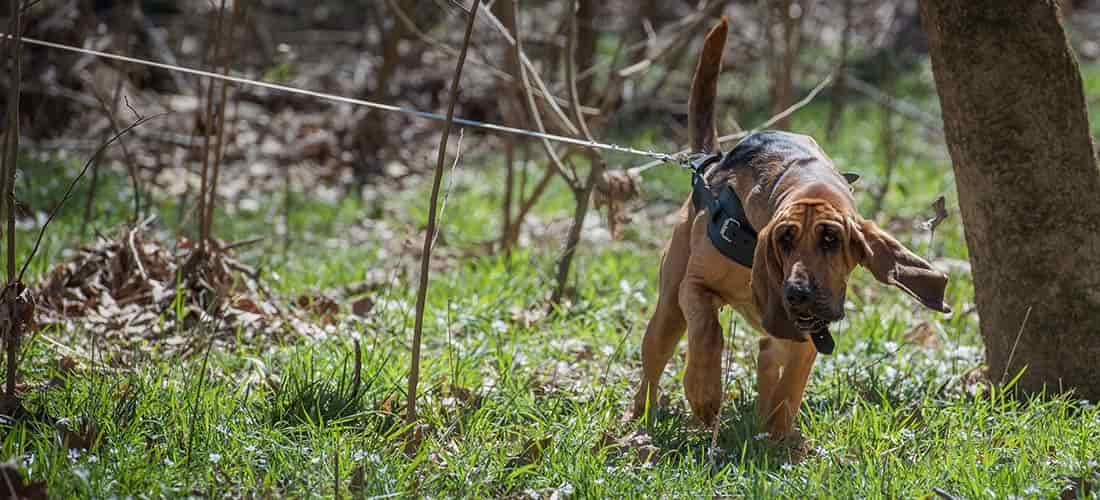
You can expect your Bloodhound to cost you a minimum of £80 per month after purchase and set-up costs and over £13,000 across their lifetime.
Costs you’ll need to think about include:
Purchase costs
Adopting an adult Bloodhound from a rescue centre may be a more cost-effective option, with the added advantage of giving a home to a pet without one – check if the rehoming centre you’re looking at asks for a donation for rehoming.
If instead you’re buying a Bloodhound puppy from a breeder, you’ll need to factor in this cost. Beware unusually cheap puppies as they could come from a puppy farm. If you’d like to buy a pedigree puppy, we recommend looking for a Kennel Club Assured breeder. These breeders must do extra health tests and meet higher standards.
Set-up costs
- Puppy vaccines – if you rescue a dog, reputable centres will often vaccinate them for you. Remember that ongoing booster vaccinations will be needed to continue their immunity.
- Neutering – you should usually arrange for your dog to be neutered at around 6-12 months old, though your vet will be able to advise you exactly when is best. Check prices at your local practice as these will depend on your vet and where you live. Some rescue centres will neuter any dogs they rehome, saving you this cost.
- Equipment – including a collar and tags, lead, harness, dog beds, dog bowls, pet-safe toothpaste and toothbrushes, grooming brushes and toys. Keep in mind that all these will need to be replaced with wear or damage or if your dog outgrows or damages them!
Ongoing costs
- Food.
- Preventive healthcare – budget for routine vet visits to help stop your dog getting ill and catch any problems early. They need annual check-ups, vaccinations and regular flea and worming treatments. Check if your vet offers a health care plan as this can help spread the cost throughout the year.
- Vet bills* or pet insurance – if you don’t have pet insurance and your dog needs veterinary treatment for an injury or illness, costs can rapidly mount up. Check what’s covered and what isn’t when comparing policies.
- Accessories – including lots of poo bags, replacing worn toys and grooming accessories, buying doggy toothpaste and any other extras they might need.
Other costs
- Training – basic training is very important and dogs can benefit from formal classes. Some dogs may have, or develop, behavioural problems which might need professional management.
- Boarding – you may also need to budget for boarding or dog sitting costs if you are planning to go away from home on holiday.
- Dog walkers/day-care – you might consider a professional dog walker to keep your dog happy and healthy if you’re unable to get out with your dog enough yourself, or to look after them during the day if you need to be out for more than four hours.
* It’s always better to plan ahead and budget or get pet insurance in case your pet gets injured or unwell. If you are having difficulty with veterinary costs, you can check if you are eligible for treatment at PDSA here.
If you’re considering pet insurance, our PDSA Pet Insurance could be a great option for you and it’s quick and easy to get a quote online.
Fun facts
- Bloodhounds are known for their sense of smell and can track both animals and people. They’re so good they can even track through water!
- They are often used by police and other authorities all over the world as sniffer dogs.
- Their sense of smell is so good that they can follow a scent trail that’s up to 300 hours old (that’s over 12 days!).
- Bloodhounds make terrible guard dogs because they really enjoy the company of people.
Getting a Bloodhound
Do plenty of research before getting a Bloodhound. These patient and gentle dogs do have a headstrong streak to them which can make training difficult at times. They enjoy company and being involved in everything around the home and can be a great family pet if you have the time (and energy!) to give them.
Rehoming centres
There are plenty of rescue centres across the country where you may find a Bloodhound. Breed-specific rescues that specialise in Bloodhounds are also out there. You’ll need to ask any rescue centre about the dog’s history to make sure they will be comfortable in your home. Good rescue centres should let you know of any health and behaviour problems.
Breeders
If you buy from a breeder, make sure your puppy will be well socialised and have all necessary screening tests, health checks and vaccinations. It’s really important that Bloodhound puppies from a breeder get the right early socialisation so always ask the breeder about how they go about this. We recommend looking for a Kennel Club Assured breeder as they meet higher standards. We’ve put together some advice to help you find a good breeder.

